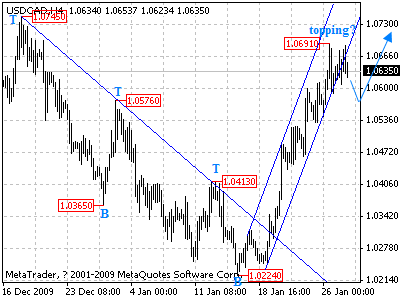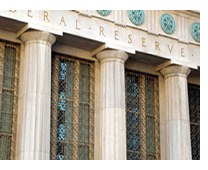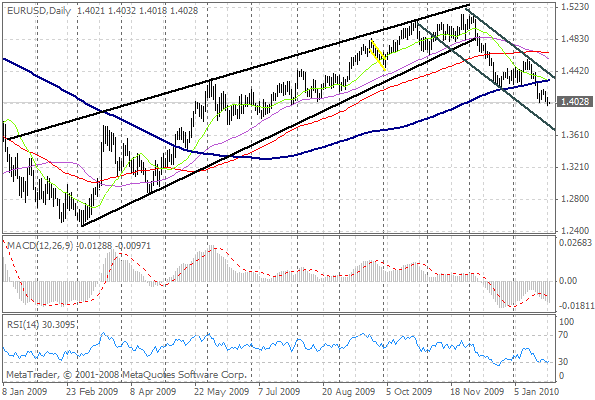By Fast Brokers – The EUR/USD has been fluctuating around its psychological 1.40 level as invertors digest the Fed’s monetary policy statement, Obama’s State of the Union Address, and today’s mixed bag of U.S. economic data. While Bernanke and the Fed played it safe and kept its policy in neutral, volatility really picked up during Obama’s State of the Union Address. The EUR/USD initially headed south to intra-session lows, but the risk trade rallied as Obama spoke and addressed the financial industry with a slap on the wrist and this encouraged investors that his proposed regulation may not be as constrictive as previously thought. However, the impact from Obama’s speech should wear off by the beginning of next week. Meanwhile, the U.S.released weaker than expected Unemployment Claims and Durable Goods data. These negative releases tack onto yesterday’s disappointing New Home Sales number, signaling the U.S. economy’s recovery is progressing very slowly. On a bright note, the Core DGO number printed above analyst expectations, showing durable goods purchases excluding autos picked up. In fact, the strong core number is probably limiting weakness in the EUR/USD right now as the Dollar wobbles. In addition to today’s U.S. data releases, the EU printed a Germany Unemployment Change figure which topped analyst expectations, a positive development for the Euro. However, the Euro is still underperforming, as highlighted by another downturn in the EUR/GBP. That being said, it seems mixed EU econ data combined with worries surrounding Greece’s economy are continuing to weigh down on the currency. The EU will release CPI and Money Supply data tomorrow to go along with the headline Unemployment Rate. Although focus will likely remain on the U.S. as it releases its Advance GDP. Meanwhile, even though the EUR/USD is sinking lower the AUD/USD and GBP/USD have firmed up over the past 24 hours, so it will be interesting to see how the Dollar reacts to tomorrow’s news.
Technically speaking, the EUR/USD faces topside technical barriers in the form of multiple downtrend lines along with 1/27 and 1/25 highs. As for the downside, the EUR/USD has our 1st tier uptrend line serving as technical cushions along with previous January lows. Our 1st and 2nd tier uptrend lines could carry some weight since they run through some April 2009 lows. That being said, a failure of our 1st tier could send a fairly negative signal considering April 2009 lows are around the 1.30.
Present Price: 1.3989
Resistances: 1.4028, 1.4069, 1.410, 1.4135, 1.4174
Supports: 1.3981, 1.3950, 1.3929, 1.3900, 1.3876, 1.3833
Psychological: 1.40, January lows
Market Commentary provided by Fast Brokers.
Disclaimer: FastBrokers’ market commentary is provided for information purposes only and under no circumstances should be regardedneither as an investment advice nor as a solicitation or an offer to sell/buy any financial product. FastBrokers assumes no responsibility or liability from gains or losses incurred by the information herein contained.
Risk Disclosure: There is a substantial risk of loss in trading futures and foreign exchange. Please carefully review all risk disclosure documents before opening an account as these financial instruments are not appropriate for all investors.








